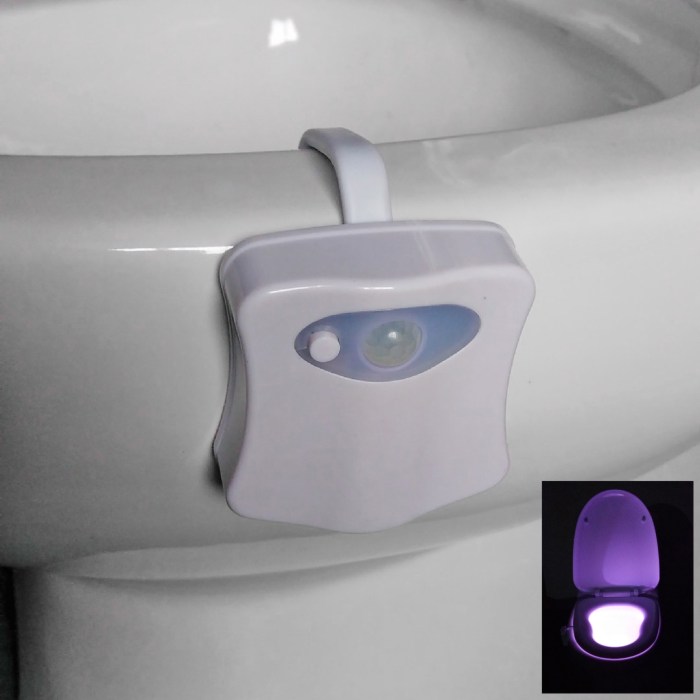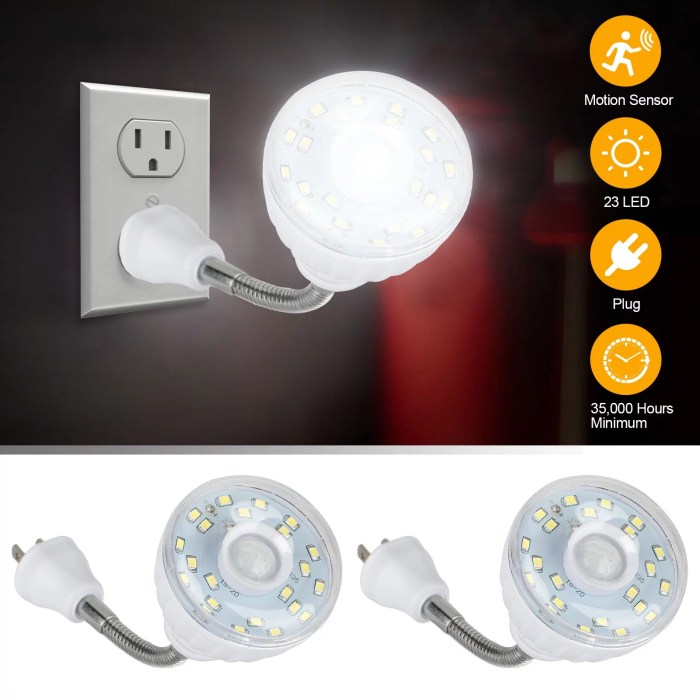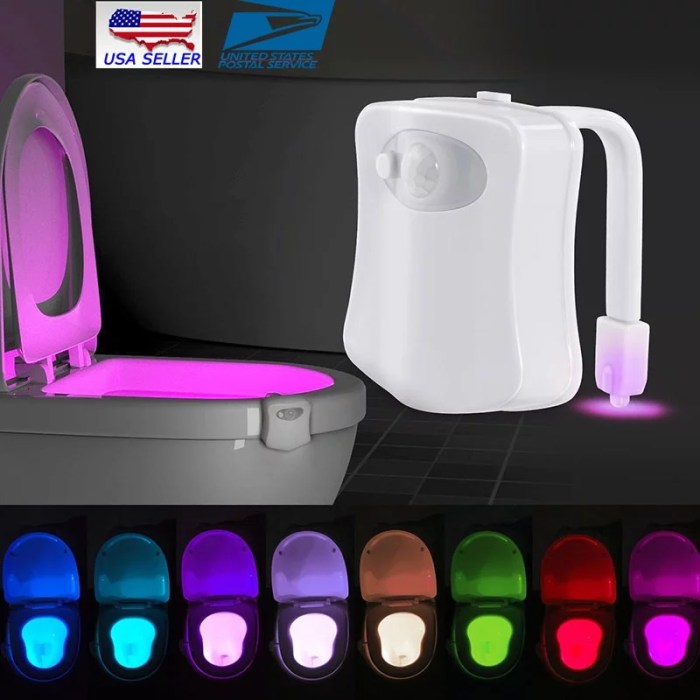Step into a world of effortless illumination with motion sensor bathroom night lights. These innovative devices combine the convenience of automatic lighting with the practicality of energy efficiency, transforming your bathroom into a sanctuary of safety and comfort.
From navigating dimly lit spaces at night to providing a comforting glow for late-night bathroom visits, motion sensor bathroom night lights offer a plethora of benefits. Let’s delve into the world of these smart lighting solutions, exploring their functionality, design considerations, and the advantages they bring to your daily routine.
Motion Sensor Technology
Motion sensors are devices that detect movement or changes in the environment. They are commonly used in various applications, including bathroom night lights, to automatically activate or adjust lighting based on motion.
There are two main types of motion sensors used in bathroom night lights:
Passive Infrared (PIR) Sensors
PIR sensors detect changes in infrared radiation emitted by objects in their field of view. When an object, such as a person, moves within the sensor’s range, the infrared radiation pattern changes, triggering the sensor.
Microwave Sensors
Microwave sensors emit high-frequency electromagnetic waves. When an object moves within the sensor’s field, the waves are reflected back to the sensor, triggering the detection.
Bathroom Lighting Needs
Bathrooms present unique lighting requirements due to their combination of functional and aesthetic needs. The space demands adequate illumination for tasks like shaving, applying makeup, or navigating safely in the dark. However, it also requires a warm and inviting ambiance for relaxation and privacy.
Motion sensor night lights offer a practical solution to these diverse needs. They provide a soft, ambient glow when the bathroom is unoccupied, eliminating the need to fumble for a light switch in the dark. When motion is detected, the night light automatically brightens, providing temporary illumination for specific tasks.
This combination of ambient and task lighting ensures optimal visibility and convenience while maintaining a cozy and inviting atmosphere.
Benefits of Motion Sensor Night Lights in Bathrooms
- Enhanced safety: Motion sensor night lights illuminate the path in the dark, reducing the risk of slips, falls, or accidents.
- Convenience: They eliminate the need to search for a light switch in the dark, providing immediate illumination upon entering the bathroom.
- Energy efficiency: Motion sensor night lights only activate when needed, conserving energy and reducing electricity bills.
- Ambiance: They create a warm and inviting atmosphere, making the bathroom a more pleasant and relaxing space.
Design Considerations
Selecting the right motion sensor bathroom night light requires careful consideration of several design factors to ensure it meets your specific needs and complements your bathroom decor.
Brightness
The brightness of the night light should be sufficient to provide adequate illumination while not being too glaring. Consider the size of your bathroom and the amount of natural light it receives during the day. A brighter night light may be necessary for larger bathrooms or those with limited natural light.
Color Temperature
The color temperature of the night light refers to the warmth or coolness of the light it emits. Warm light (around 2700-3000K) creates a cozy and inviting atmosphere, while cool light (around 4000-5000K) provides a more energizing and functional environment.
Choose a color temperature that complements the overall ambiance of your bathroom.
Aesthetics
The aesthetics of the night light should match the style of your bathroom. Consider the shape, size, and finish of the fixture. Some night lights feature sleek and modern designs, while others have a more traditional or decorative appearance. Choose a night light that complements the existing decor and enhances the overall look of your bathroom.
Installation and Maintenance
Installing a motion sensor bathroom night light is a simple and straightforward process. Here are the steps:1.
-
-*Choose a location
Select a suitable spot in your bathroom where the light can detect motion effectively. It should be away from direct sunlight or other light sources that may interfere with its operation.
- 2.
- 3.
- 4.
-*Mount the light
Use the included mounting hardware to attach the light to the desired location. Ensure it is securely fastened and stable.
-*Adjust the sensitivity
Once the light is mounted, adjust the sensitivity knob to determine the range of motion that triggers the light.
-*Test the light
Walk past the sensor to verify that it is working correctly. If necessary, fine-tune the sensitivity until you achieve the desired response.
Maintenance
To maintain the light and ensure optimal performance, follow these steps:1.
-
-*Clean the sensor
Regularly clean the motion sensor with a soft, dry cloth to remove dust and debris that may accumulate over time.
- 2.
- 3.
-*Replace batteries
The light is typically powered by batteries. Replace the batteries when the light becomes dim or stops working altogether.
-*Check the mounting
Periodically check the mounting hardware to ensure that the light remains securely attached. Tighten any loose screws or bolts as needed.
Product Comparisons

Motion sensor bathroom night lights offer convenience and safety in dimly lit spaces.
To help you make an informed decision, we have compiled a comparative table highlighting key features, prices, and customer reviews of various models.
Consider the following factors when comparing products:
- Motion detection range and sensitivity
- Light output and color temperature
- Battery life and charging method
- Installation and mounting options
- Additional features (e.g., adjustable brightness, night mode)
Product Comparison Table
| Product | Features | Price | Customer Reviews |
|---|---|---|---|
| Product A | – Motion detection up to 15 feet
|
$19.99 | 4.5/5 stars (100+ reviews) |
| Product B | – Motion detection up to 12 feet
|
$14.99 | 4.0/5 stars (50+ reviews) |
| Product C | – Motion detection up to 10 feet
|
$24.99 | 3.5/5 stars (30+ reviews) |
Pros and Cons
Product A:* Pros: Long motion detection range, rechargeable battery, adjustable brightness
Cons
Higher priceProduct B:* Pros: Affordable, night mode, easy installation
Cons
Shorter motion detection range, disposable batteriesProduct C:* Pros: Multi-color light, remote control, USB rechargeable
Cons
Shortest motion detection range, higher price, fewer customer reviews
DIY Options
Creating a DIY motion sensor bathroom night light offers a cost-effective and customizable solution. With readily available materials, you can tailor the design to your specific bathroom needs and preferences.
Materials Required
* LED strip lights
- Motion sensor module
- Power supply
- Wire connectors
- Screwdriver
- Measuring tape
Steps
- Measure and cut the LED strip lights to the desired length.
- Connect the motion sensor module to the LED strip lights using wire connectors.
- Mount the motion sensor module in a suitable location using screws or adhesive.
- Connect the power supply to the motion sensor module.
- Test the night light by moving in front of the motion sensor.
Benefits of DIY Projects
*
-*Customization
Tailor the night light to your bathroom’s size, shape, and lighting requirements.
-
-*Cost-effectiveness
Save money compared to purchasing a pre-made night light.
-*Educational value
Engage in a hands-on project that teaches basic electrical principles.
Challenges of DIY Projects
*
-*Electrical knowledge
Requires basic electrical knowledge and skills.
-
-*Time-consuming
Can be more time-consuming than purchasing a pre-made night light.
-*Troubleshooting
May require troubleshooting skills if the night light malfunctions.
Smart Home Integration
Integrating motion sensor bathroom night lights with smart home systems enhances convenience, personalization, and energy efficiency.
By connecting the lights to smart home hubs or apps, users can control them remotely using voice assistants or mobile devices. This allows for seamless on/off switching, brightness adjustments, and scheduling based on preferences and routines.
Advantages
- Remote control via voice assistants or mobile apps
- Scheduling and automation based on time, motion, or other triggers
- Integration with other smart home devices for a cohesive lighting ecosystem
- Enhanced energy efficiency through motion detection and automatic shut-off
Last Point
Incorporating motion sensor bathroom night lights into your home not only enhances safety and convenience but also adds a touch of sophistication to your bathroom’s ambiance. By carefully considering factors such as brightness, color temperature, and aesthetics, you can find the perfect light to complement your bathroom’s decor and create a welcoming atmosphere.
Whether you opt for a sleek and modern design or a more traditional style, these night lights will seamlessly blend into your bathroom’s aesthetics, providing both functionality and visual appeal.


